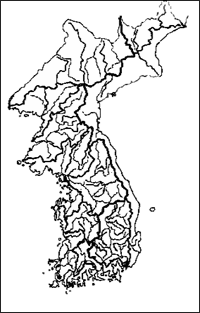CAC CONTENTS
-

-
CAC Contents
-
Outline
- Outline
- Mountaineering around the capital
- Mt. Sorak with fascinating sights
- A great volcaic upheaval
- Scaling of high mountains aborad
- Overseas expeditions by CAC & KAF
- Vigorous climbing movement in Korea
- New Start
- Korean Rock by Rick Ruffin
- Seoul Big Slab by Rick Ruffin
- Winter Trill in Korea by Cho sung dae
Outline
Outline
-

-
Korea is geomorphologically characterized by abundant hills and mountains, which occupy nearly 70% of its territory. Low hills, mostly located in the S and W, give way gradually to increasingly higher mountains toward the E and the N, the highest terrain rising in the NE area.
On the whole, the W and S slopes of the Korean peninsula are gentle with various flatlands, low hills and basins developed along several large rivers, while the E slope is quite steep with no significant rivers and plains because mountains are everywhere close to the E coast. The W and S coasts are repeatedly indented and there are innumerable islands, while the E coastline is generally straight with few islands.The Korean mountains risen in ranges in 2 major directions with form the skeleton of the peninsula.
The most remarkable range is the Taebaek mountains, which run in a NS(or peninsula) direction along the E coast. It constitutes the drainage divide between the W and the E slopes. Mt Sorak(1708m) and Mt Taebaek(1546m) are located along this dividing the ridge.
The former in particular is renowned for its beauty with various spectacular landforms carved out of granite masses: a series of rocky pinnacles rising into the sky, deep and narrow canyons bordered by nearly vertical, granite walls, various well-developed joint systems shown in the valleys in terms of boulders, larger blocks of rock, numerous waterfalls, cascades and rapids along clean streams and so on.
The peninsula is a rather stable land mass in spite of its proximity to the Japanese archipelago so that Korea has neither active volcanoes nor significant earthquakes nowadays.
However, there are some extinct ones like Mts Paekdu and Sojin-bong, which are believed to have been formed during late Tertiary or early Quarternary.
The former is famous for its enormous crater lake called Chonji, meaning 'Heavenly Lake'. Mt Halla (1950m) on Cheju Island, the highest peak in S Korea, has a record of eruption as recent as sometime in the middle of Koryo Dynasty period. It has become a typical attraction for alpinists as well as tourists from abroad.


 ENGLISH
ENGLISH


